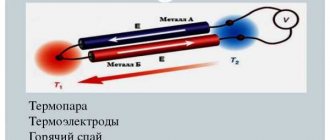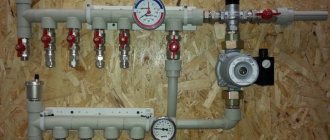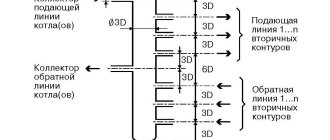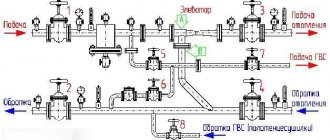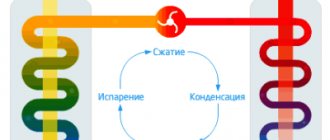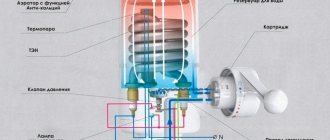The use of sanitary manifolds with shut-off valves increases the comfort of using water.
If the distribution is made with one pipe from the riser, then when several taps are opened, the water pressure in them weakens. As a result, for example, you can get burned in the shower if someone turns on the water in the kitchen.
A distribution manifold eliminates this problem. From the article you will learn more about what a water supply collector is and how to choose it.
Definition of the term “collector”
Water in the house always flows into the bathroom and kitchen. However, they still cannot do without it in a bathhouse, swimming pool, sauna, shower, and so on. Water supply must be ensured for all consumers, which are, for example, a sink, toilet, dishwasher and washing machine.
The water collector is a technical element. This part of the indoor water supply network is also called the comb. It is installed at the beginning of the system with cold and/or hot water. The installation of this important element is carried out, for example, in the boiler room of a private house or in a room where water treatment is carried out.
When choosing the installation location, free access to the water collector is ensured. It should not subsequently be cluttered with furniture and other objects. The comb cannot be tightly sewn into the building structures of the house. Often such a technical element is covered with a decorative false panel to improve the plumbing unit.
The presence of a collector in the water supply system of a house allows water to be delivered to each water distribution point. Their number is individual in all private residential buildings.
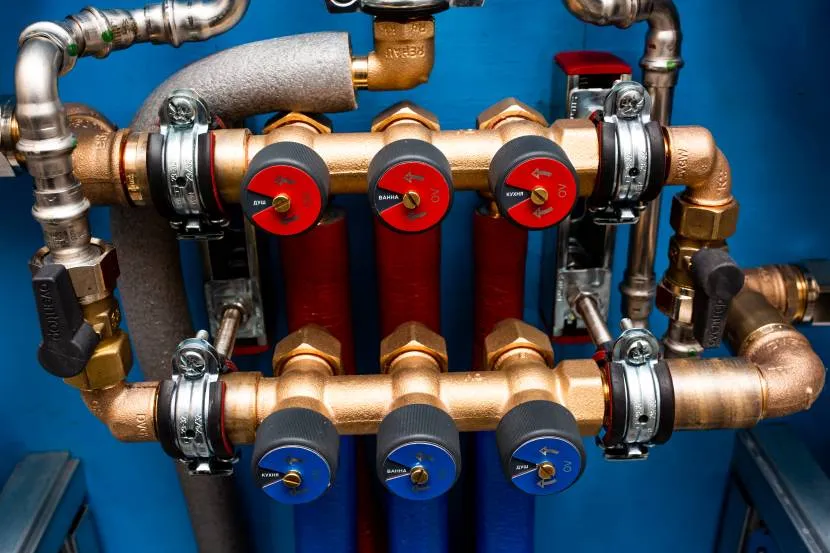
Mounted collectors in a private residential building Source oventrop-home.ru
A simplified version is two sinks, a bathtub and a toilet. Although modern houses have several toilets and bathrooms. Many homeowners combine such premises and install a large number of additional household devices, the operation of which is carried out only after connecting to the water supply.
Design and principle of operation of the collector
The main function of the comb collector is to distribute water to all plumbing fixtures. With the help of this element, the total flow is distributed into several parts that will not differ in pressure.
Manufacturers make combs with multiple outlets. Their number ranges from 2 to 4 pieces. When it is necessary to distribute water to more devices, then the devices are connected to each other. In this case, they focus on the required number of branches. If there are more of them, then unnecessary outlets are closed with plugs.
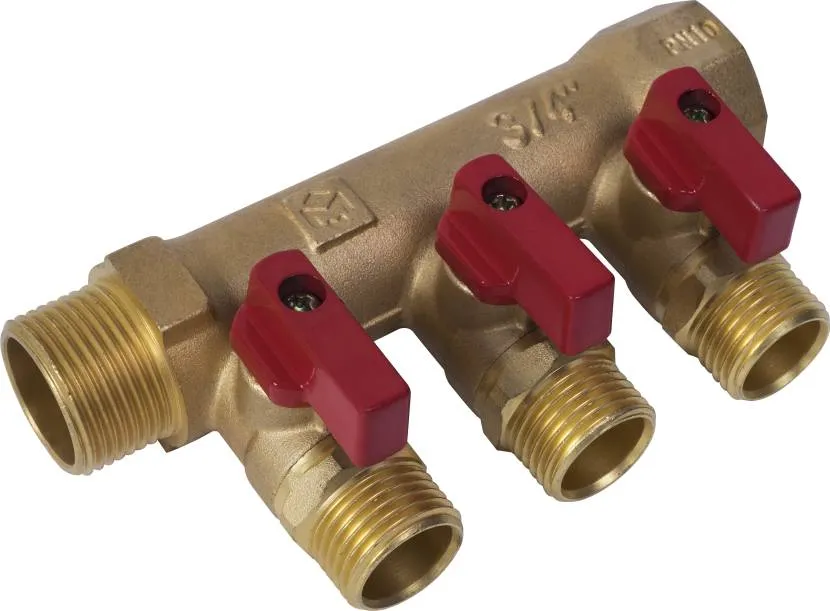
Comb with three branches Source leroymerlin.ru
The comb is made in the shape of a cylinder. Therefore, a collector is a pipeline whose diameter is larger than the cross-section of the connected pipes. At one end of this plumbing device there is an internal thread, and on the other side there is an external thread. This design allows the combs to be interconnected and connected to a supply line with hot or cold water.
The free end of the plumbing fixture is closed with a plug or an additional device is installed in this place. This is, for example, a device to prevent water hammer.
The cross-section of the comb inlet is always larger by 20% or even 40% of the diameters of the branches. Distribution devices with 3/4 inch inlet are often installed. Moreover, their outlets are 1/2 inch in size.
It is possible to mount a water supply manifold, whose outlet openings are equipped with taps or valve mechanisms. Both options allow you to shut off the flow in each branch. Using valves, you can also regulate the water supply power.
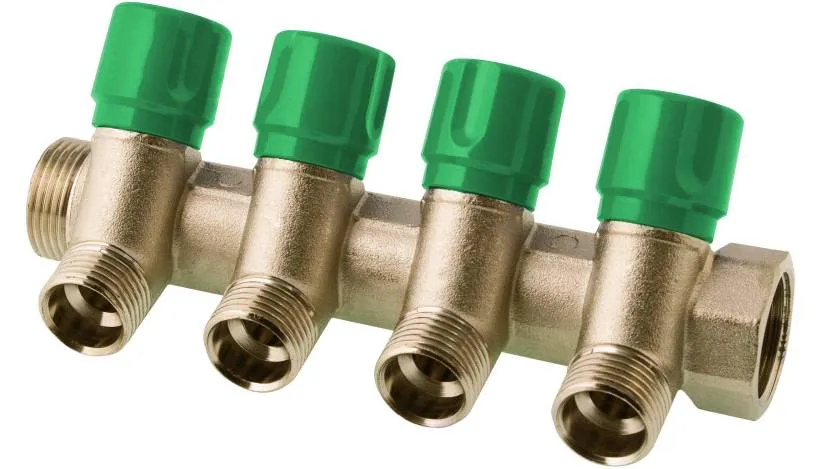
Water distribution device with four valves Source feko.com.ua
See also: Catalog of companies that specialize in water supply, sewerage and related work
Why do you need a collector in a water supply system?
An autonomous water supply system for a house outside the city or in a village has many methods of implementation in practice, and one of the ways to organize an effective system for the delivery and distribution of water to water collection points in the house is to install a water supply collector.
What is a water supply collector - features and purpose
A collector, or “comb,” is a short piece of metal, metal-plastic or polypropylene pipe into which several pipes of the same pipe are cut at an equal distance from each other - the number depends on the functionality and power of the pipeline. Thus, this system of pipes acts as a central distributor of water flows.
Next, pipelines, control instruments and devices are connected to the pipe outlets.
This distribution scheme is also called radial, since pipe sections in the form of beams are diverted from the central collector in different directions.
The main function of the collector pipeline is to ensure a uniform supply of water to devices and mains, as well as to ensure the independence of each of the connected branches (beams) of the collector in the general water supply.
Options for water supply manifolds differ schematically and structurally in the following solutions:
- Inclusion in the scheme of auxiliary secondary equipment - with shut-off valves, control and regulating devices, pumps, gearboxes and pressure gauges, sensors and pressure switches. But which water supply collector is recommended to choose can only be decided based on the specific water supply scheme in the house;
- Options for using materials for a home water supply comb: steel, non-ferrous metals - brass, copper, bronze, as well as plastic or silumin. The last knots are the cheapest, but also the most short-lived. Usually the material is chosen based on the material of the general household water supply: if it is metal, then the water supply collector is made of steel pipes, etc.;
- A standard factory comb has from two to four pipes, but there are exceptions. For example, with a complex wiring diagram, experts recommend combining several combs into one, which means that the number of taps will increase proportionally.
In addition, the choice of a comb for water supply depends on the design, parameters of the water pipeline and the functionality of the water supply system:
- Maximum system pressure;
- Capacity of the comb and water supply main;
- The distance between the centers of the axes of the exhaust pipes, if this is a factory comb.
Advantages of installing a collector device
Distributing water to each consumer according to the classical scheme using tees is cheaper than collecting water pipes. However, the use of combs has a number of advantages.
Distribution devices allow you to regulate the pressure in each branch. If you install a water supply system according to the classical scheme, then a decrease in pressure often occurs in an open mixer, for example, above a bathtub. This situation can occur when someone in the house uses the toilet, washes dishes in the kitchen sink, or turns on the washing machine.
The pressure difference will cause a change in water temperature. This leads to discomfort while taking a bath. A person can even get burned due to the increase in water temperature. A water collector for plumbing helps to avoid situations. It prevents pressure drops in the home system.

The use of a comb collector reduces the likelihood of a sharp change in water temperature in an open tap Source 299999.ru
Combs with valve mechanisms on the branches to regulate the water supply in each branch allow you to repair faulty plumbing fixtures. In this case, there is no need to shut off the entire water supply system.
The use of comb collectors also allows you to reduce the number of joints in the water supply. Thanks to this wiring scheme, the likelihood of leaks in the house is reduced. After all, a single pipeline can be laid from the collector to each water collection point.
In addition, combs allow you to quickly install additional plumbing if necessary. In this case, there is no need to redo the existing system.
However, the collector distribution of water supply pipes is characterized by high consumption of materials. Its implementation requires almost 8 or even 10 times more pipelines than for installing a water supply system according to the classical scheme. To reduce the cost of creating such a system, it is recommended to use pipes made of metal-plastic or polypropylene.
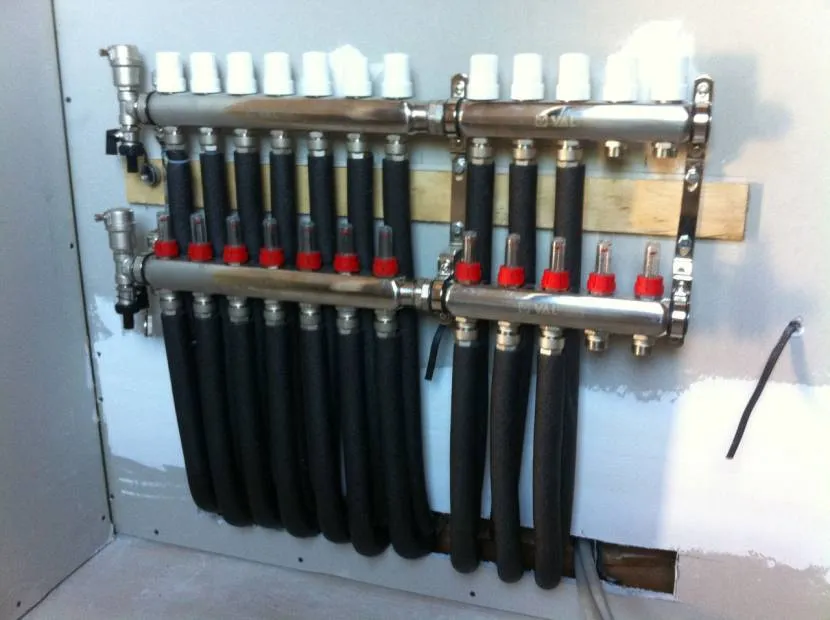
If there are collectors, separate water pipes are supplied to all plumbing fixtures Source kotel02.ru
Water supply collector: why is it needed, which one to choose
An autonomous water supply system for a house outside the city or in a village has many methods of implementation in practice, and one of the ways to organize an effective system for the delivery and distribution of water to water collection points in the house is to install a water supply collector.
What is a water supply collector, features and purpose?
A collector, or “comb,” is a short piece of metal, metal-plastic or polypropylene pipe into which several pipes of the same pipe are cut at an equal distance from each other - the number depends on the functionality and power of the pipeline. Thus, this system of pipes acts as a central distributor of water flows.
Next, pipelines, control instruments and devices are connected to the pipe outlets.
This distribution scheme is also called radial, since pipe sections in the form of beams are diverted from the central collector in different directions.
The main function of the collector pipeline is to ensure a uniform supply of water to devices and mains, as well as to ensure the independence of each of the connected branches (beams) of the collector in the general water supply.
Options for water supply manifolds differ schematically and structurally in the following solutions:
- Inclusion in the scheme of auxiliary secondary equipment - with shut-off valves, control and regulating devices, pumps, gearboxes and pressure gauges, sensors and pressure switches. But which water supply collector is recommended to choose can only be decided based on the specific water supply scheme in the house,
- Options for using materials for a home water supply comb: steel, non-ferrous metals - brass, copper, bronze, as well as plastic or silumin. The last knots are the cheapest, but also the most short-lived. Usually the material is chosen based on the material of the general household water supply: if it is metal, then the water supply collector is made of steel pipes, etc.
- A standard factory comb has from two to four pipes, but there are exceptions. For example, with a complex wiring diagram, experts recommend combining several combs into one, which means that the number of taps will increase proportionally.
In addition, the choice of a comb for water supply depends on the design, parameters of the water pipeline and the functionality of the water supply system:
- Maximum system pressure,
- Capacity of the comb and water supply main,
- The distance between the centers of the axes of the exhaust pipes, if this is a factory comb.
Classic wiring diagram
The usual layout of water supply pipes around the house is tee or sequential: a pipeline is drawn from the main riser, to which the necessary devices and equipment are connected through tees and bends.
This connection technology is advantageous in the following ways:
- Minimum total length of pipes,
- Low hydraulic resistance in the water supply system.
In practice, this scheme has not proven itself to be very good - it turned out that it was better to implement the connection through a comb. The disadvantage of the traditional connection is that when several valves are opened simultaneously, the pressure in one of them, or in both, drops.
Collector water supply system
If a collector is included in the system, then whatever device is installed in the circuit, a separate outlet will be laid to it. The total length of the pipes increases, but the following positive aspects appear:
- There will always be a stable and equal pressure at all water intake points,
- When inserted into the manifold branch of the reducer in this branch, suitable for any plumbing fixture, the pressure can be adjusted, and it will be different from the general value,
- Each insert between the collector and the water collection point is a single piece of pipe that can be discreetly fixed in the floor, in a wall or in a wall niche,
- Any plumbing fixture can be turned off without stopping the entire cold water supply or domestic hot water supply for repair or replacement.
Disadvantages of the collector circuit:
- A larger pipe length automatically increases the hydraulic resistance in the line,
- Due to the increase in the length of the line, the collector will not operate in natural water circulation mode, which may affect the choice or change of the heating system,
- If it is impossible to ensure that the pipe system is hidden in walls or niches, then a large accumulation of pipes can force you to change the interior or even the design of the premises.
Rules for installing plumbing and heating systems
In systems involving working fluid, two collectors are cut into the line - for supply and for return. When manually balancing the system, control shut-off valves and balancers-flow meters are connected to the outlets of the supply manifold, and valves or taps are installed on the liquid return pipe.
According to calculations, it is possible to replace the control valves with shut-off valves, but then there is a risk of faster failure of taps and valves due to an unintended operating mode of the equipment.
If a thermostat is built into the circuit, then the manual valves on the supply manifold can be replaced with valves with a servo drive to automate the operation of the system.
In this case, the liquid supply manifold is mounted above the return manifold, and water pipes can be mounted at any height.
Features of the design of water supply in home heating
If the heating system is made according to a combined scheme, then the radiators work in tandem with the pipeline of the “warm floor” system, and the water supply collector is equipped with a mixing unit so that when the liquid in the heated floor circuit cools, water from the collector is added to this circuit by mixing.
When purchasing a ready-made manifold, it is recommended to pay attention to the distances between the outlets of the supply and return manifolds, since in Asian devices these values may not correspond to European standards, and the water mixing unit may simply not fit.
Manifold for water heated floor
The manifold for “warm floors” has outlet pipes Ø 16 mm, 18 mm and 20 mm. For highways laid in country houses, it is recommended to install pipes with Ø ≤ 16 mm.
If there are several “warm floor” circuits in the house, and they have different lengths, then the collector needs a balancing system with a flow meter, since without a balancer, the floor with a shorter pipe route will always be hotter.
By rotating the ring on the flow meter, its throughput capacity is changed, and therefore the temperature in the circuit is regulated. The hot water consumption is visually controlled through a special slot with a scale.
Rules for installing water supply systems
For the water supply main, collectors are also installed in two units: one collector for hot water supply, the other for cold water supply. When implementing such a solution, no control valves will be needed - only shut-off valves or taps are installed.
Such taps in the cold water supply line are equipped with blue handles, for hot water supply - with red handles. The main water supply manifold pipe is installed in a dry place, but the ideal solution would be to install a separate cabinet for the manifold.
For this purpose, factory units are equipped with special fasteners, and there are places for them in factory cabinets.
When making a collector with your own hands, the method and scheme of placement and fastening of the collector will need to be thought out separately - choose any option that ensures the conditions described above.
Classification of distribution manifolds
Manufacturers produce combs from various materials. They differ in design. Currently available on the market:
- Stainless steel devices that are lightweight, corrosion resistant, and able to withstand high temperatures and open flames. The attractive steel used does not pose any danger to humans.
- Polypropylene lightweight devices that do not rust.
- Durable brass combs are corrosion-resistant plumbing elements. They are expensive, but allow you to distribute even very hot water.
Manufacturers produce comb collectors in which the center-to-center distance between branches can range from 36 to 100 mm. The devices also differ in the way the pipes are connected to the branches. There are several options:
- thread;
- eurocone - for connecting most types of pipes through a special adapter;
- polypropylene bends - intended for soldering pipelines made of the same material;
- compression fittings - allow you to connect metal-plastic pipes.
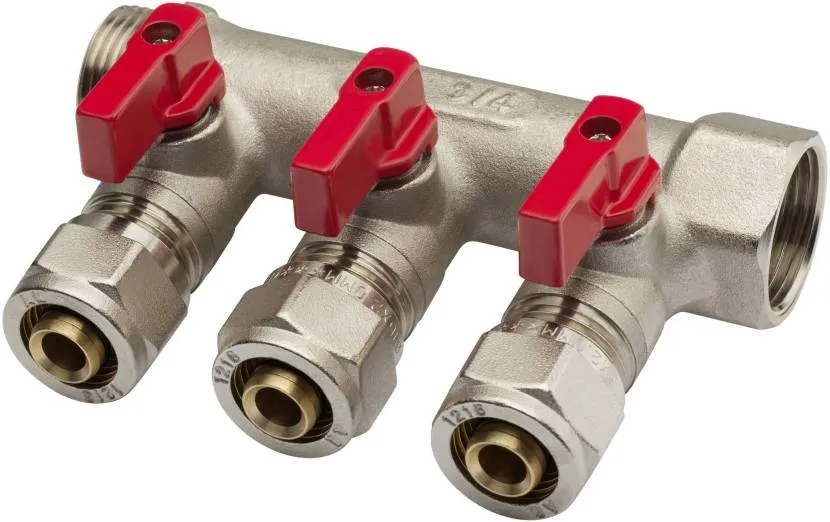
Manifold with compression fittings Source bavariaplus-remont.ru
Cranes and other components
When choosing a collector for water supply, professionals will always help you determine which is best from the existing range. Specialists will take into account the allocated budget and the material of the pipes from which the wiring in the house will be created. In addition, simultaneously with the comb, all components are selected to create a full-fledged distribution unit of the water supply system:
- valves;
- pressure gauges;
- pumps;
- valves;
- fasteners;
- plugs;
- couplings;
- filters;
- counters;
- fittings.
Manufacturers also produce manifold cabinets. They are built into the wall or mounted on its surface. Their use allows you to improve the distribution unit and provide free access to it.
Combs are produced with and without taps. When using the latter option, you still have to install shut-off valves, but they can always be replaced when a breakdown occurs. If you choose a collector with built-in taps, you will have to completely change the distribution element of the water supply system.
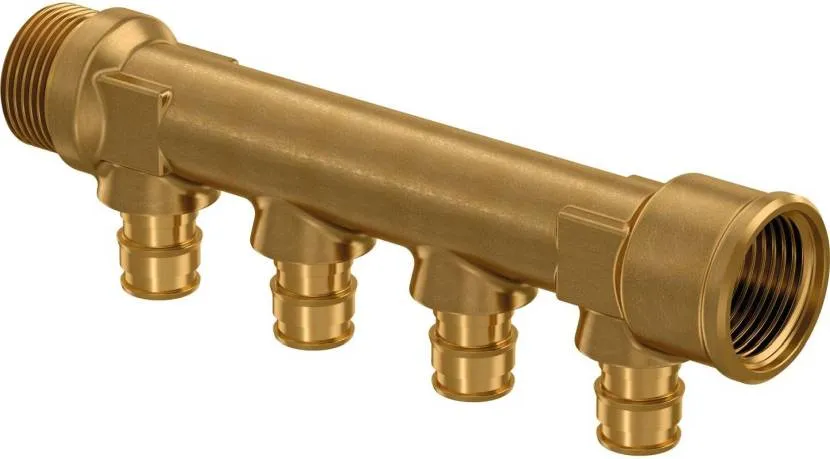
Manifold-comb without taps on taps Source komsis.su
Products on the market
Depending on the material, the cost of products ranges from 400 to 2500 rubles. Collector groups for 200-300 outputs can cost 10,000-40,000 rubles.
There are models from different manufacturers on the market, the popular ones include:
- Watts;
- Uponor;
- Giacomini;
- APC;
- Luxor;
- Fado;
- Caleffi;
- Valtec;
- Bianchi.
The stores offer not only combs, but also accessories. Products without taps are economical. They are used to install individual wiring and make it possible to select suitable parts. Purchasing a product with shut-off valves will make the installation process easier. When assembling the units, the need to install valves disappears.
To adapt the device to the home system, components are purchased. These include valves, valves, and pump groups. Mechanical drives, plugs and pipes are required.
Manifold cabinets are used for wall mounting and maintaining an aesthetic appearance.
Installation Features
Before installation work, professionals always first determine:
- Number of consumers. The number of outlets on the comb may be greater, but not less than the water points.
- Type (material) of pipes to each device.
- Installation locations for additional components of the distribution unit. Their attachment points are marked on the wall.
- Necessary consumables and their quantities.
The collector installation process itself is carried out in stages:
- install shut-off valves on the inlet line;
- install check valves, meters and filter elements;
- connect and secure the switchgear;
- lay pipes to each water point;
- connect pipelines to the collector.
All work can be performed with high quality only by professionals. The whole process takes more time than installing a water supply according to the classical scheme.
Installation rules
You can do the wiring of the water supply network with the installation of the collector yourself. It is assembled according to this scheme: the main pipe is connected to the comb directly, without any branches. Pipes supplying water to each plumbing fixture are connected to it. The devices are conveniently installed behind the toilet flush cistern. But other versions are also acceptable.
To choose a location for the comb, take into account:
- accessibility for repair and installation;
- humidity (moderate);
- the presence of a load-bearing wall on which the device is fixed;
- the ability to work in case of an accident at any time of the day thanks to additional lighting.
Sometimes the device is installed in a separate room or closet. To secure the collector, special clamps are used.
Combs are installed for both hot and cold water supply. For ease of use and to avoid confusion, manufacturers produce collectors in two shades: red and blue.
The installation should be carried out only after the wiring has been installed, meters, check valves, filters and other parts of the water line have been installed. At the connection point to the main riser, the system is equipped with ball valves that shut off the main flow. There is also a coarse filter and a meter that allows you to control water consumption.
It will be necessary to complete the installation of water lines for each point of consumption. To do this, it is worth leaving free outlets in the collector, plugging them with plumbing plugs. Only after this can the unit responsible for distribution be installed. Install it without additional sealing.
Carrying out installation in this order will reduce the load on the connections and help avoid their deformation. This is especially true for non-professionals.
When installing, you need to take into account the following points:
- The device responsible for distribution is certainly equipped with shut-off elements for adjusting and shutting off the flow.
- The cross-section of the connection point to the main line must be larger than the standard 15 mm. This diameter of the inlet pipe makes it possible to provide the consumer with the required amount of water while simultaneously using several plumbing fixtures.
- To neutralize water hammer, which can cause serious damage to the water supply, you need to install a special damper.
- Adapter fittings are installed on the threaded connection of the valves or the outlets from the manifold. Pipes supplying water to points of consumption are connected to them.
- When equipping a building with two or more floors with water supply, it may be necessary to install a circulation pump.
If a hidden water distribution system scheme is chosen, you will need to install thermal insulation material on the supply pipes. This method allows you to avoid cracking of the screed or the places where the grooves are sealed. Heat loss in the hot water supply pipeline will also be reduced.
Briefly about the main thing
The manifold is used to distribute the flow evenly to each plumbing fixture. At the same time, the pressure remains constant, even if the flow of hot or cold water unexpectedly increases.
Combs are made of brass, stainless steel and polypropylene. They look like a pipeline with an increased diameter. It is equipped with several outlets with or without taps. The presence of shut-off valves allows you to turn off one of the water points at any time in order to carry out repairs. At the same time, in all other premises water can be used without restrictions.
The installation of the collector is carried out after installing the valve, meter, filter and shut-off valves on the inlet line. A fixed comb is connected to pipelines to each water point.
Ratings 0


